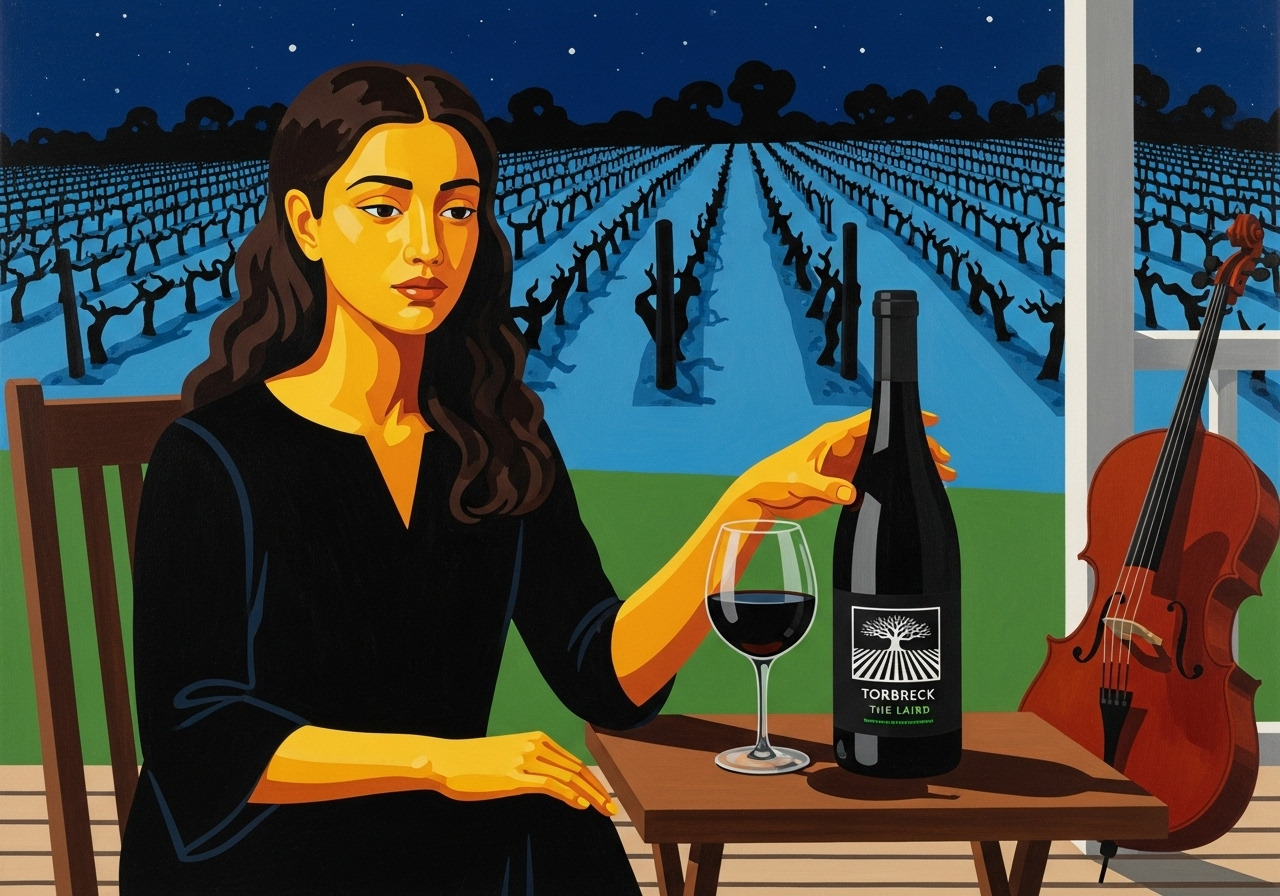The Iron and the Orchard: Torbreck The Laird 2015
Deep, poetic guide to Torbreck The Laird 2015 food pairing—from roast lamb to truffled mushrooms, served at 18 °C with reverence and time.

The first pour glows like a black garnet—thick, slow-moving, light clinging to the rim as if hesitant to let go. Even in youth, the 2015 Torbreck The Laird needs an hour’s decant to let its iron heart breathe. At 18 °C in a wide-bowled glass, the initial density begins to lift: plum and black cherry, cedar smoke and roasted fennel, the faint shimmer of graphite under dark velvet. There is Barossa heat in its blood, but also patience—a slow revelation rather than a rush. I have seen wines that roar from the glass; this one hums like a cello, deep and resonant, waiting for the right company.
The Earth Beneath the Wine
From Australia’s Barossa Valley, The Laird is the crown jewel of Torbreck Vintners, crafted by winemaker Ian Hongell from centenarian Shiraz vines in the Gnadenfrei sub-region of Marananga. These low-yielding vines, rooted in ironstone and clay over schist, feel the furnace of the South Australian summer by day and its sudden cool relief by night. The result is concentration tempered by balance—fruit ripeness held taut by structure. Here, the land itself writes its own dialect: minerality translated as muscular grace, density enlivened by spice. The 2015 vintage was warm and even, producing wines of immense depth and longevity, destined to unfurl through 2040 and beyond.
A Wine of Power and Discipline
Even decanted, The Laird 2015 moves deliberately. Aromas build in strata: cassis, black olive, charred rosemary, and smoked meat, underpinned by cocoa and a flicker of violet. On the palate, the texture is massive yet surprisingly defined—the tannins fine-grained and persistent, the acidity a cool seam through the warmth. French oak lends a frame of sandalwood and cigar box, but it never overwhelms. The finish runs on and on, like dusk across a red plain. This is not a wine of comfort but of confrontation—beautiful, formidable, demanding reverence. It is the kind of Shiraz that will evolve for decades, its thunder softening into symphony.
Char and Fat: The Dance of Strength
When I taste a wine like this, I think of the great pairings that honor its scale rather than compete with it. Lamb shoulder slow-roasted until the meat shreds at the touch of a fork finds its perfect mirror here. The wine’s tannin—those gentle, drying grips on the cheeks—melds into the lamb’s fat, rounding into silk. The rosemary and garlic echo the wine’s herbal and smoky undertones, each mouthful closing the loop between pasture and vine. Likewise, a ribeye grilled over charcoal, rested until its juices pool, makes the Shiraz sing; the sear calls to the wine’s char, the sweetness of the meat answers its dark fruit. This is the oldest law of the Barossa: meat for strength, wine for memory.
Fire and Fruit: Bold, Adventurous Pairings
For the adventurous table, The Laird can stand alongside spice if the cook understands restraint. Think of Moroccan lamb tagine with prunes and almonds—the dried fruit teasing out the Shiraz’s black cherry and plum, the nuts grounding its richness. The wine’s structure tempers the dish’s sweetness while its spice embraces the cumin and cinnamon. Or pair it with Korean short ribs lacquered in gochujang: the chili’s heat softened by the wine’s plush fruit, the umami linking to its savory depth. Served at the right temperature—never above 19 °C, lest the alcohol rise—the effect is an equilibrium between fire and fruit, salt and smoke.
Earthly Luxuries: Vegetables That Dare
Vegetarian pairings demand texture and umami to meet such gravity. Wild mushroom ragout with truffle butter offers the necessary savor, the wine’s acidity cutting through richness while the earthy tones create harmony. Charred eggplant, brushed with miso and olive oil, can surprise—its smoke and salt draw out the Shiraz’s darker side, the sweetness of the flesh catching the fruit’s glow. With both, the tannin softens, the fruit deepens, and the wine becomes almost meditative. One must not fear to serve a great red with plants; the vine, after all, loves the soil more than the slaughterhouse.
Small Indulgences, Long Echoes
As the bottle wanes and conversation lengthens, small indulgences keep pace: a slab of polenta crisped in butter, its edges golden and yielding, or roasted root vegetables glazed in balsamic reduction. These sides bridge the structural gap between intensity and comfort, the acidity in the glaze sharpening the wine’s finish, the caramelized sugars resonating with its fruit. Dessert, however, would be a betrayal. Better to close with a wedge of aged cheddar or a smear of Gorgonzola dolce—the salt drawing out sweetness, the fat coaxing the last tannins into velvet.
The Scribe of the Vine Speaks
In the old stories, I was called the Lady of the Steppe—the scribe who records what endures. In The Laird 2015, I hear the same record: a century of vines, scorched seasons, the patience of wood and stone. Each vintage writes another line in the book of the earth, and each meal shared beside it is a brief annotation—fleeting, fragrant, human. So treat this wine as you would a sacred text: pour it into a broad glass, let it breathe an hour, serve it with care and generosity. It is vivid now, but its truest voice will come in the next decade, when the fruit and oak resolve into story rather than song.
May your table be wide, your fire low, your company kind. In the silence after the last sip, you might still hear the hum of Barossa’s red soil—the pulse of a vine that has seen more harvests than most empires.





